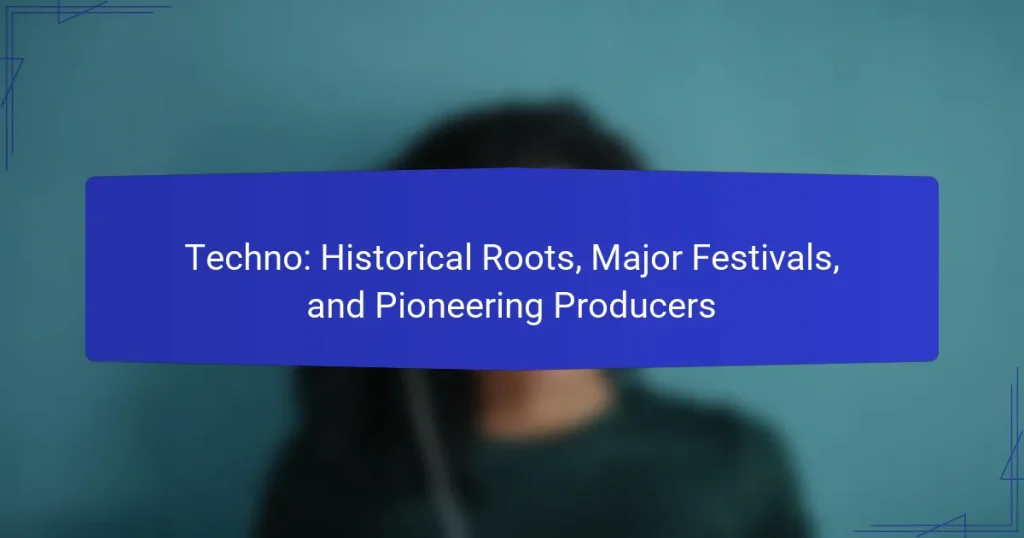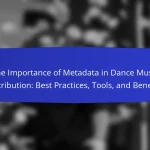Techno is a genre of electronic music that originated in the 1980s in Detroit, Michigan, through the fusion of house, funk, and electro music. Key figures in the development of techno include Juan Atkins, Derrick May, and Kevin Saunderson, collectively known as the Belleville Three, who significantly influenced the genre with their innovative production techniques. Techno’s characteristics include repetitive beats and synthesized sounds, which gained international recognition in the 1990s, leading to the establishment of major festivals like Movement Detroit, Awakenings, and Tomorrowland. This article explores the historical roots of techno, highlights major festivals that celebrate the genre, and profiles its pioneering producers who laid the foundation for its global influence.

What are the Historical Roots of Techno?
Techno originated in the 1980s in Detroit, Michigan. It emerged from the fusion of electronic music genres such as house, funk, and electro. Key figures like Juan Atkins, Derrick May, and Kevin Saunderson pioneered the sound. Their work was influenced by the technological advancements in music production. The genre is characterized by repetitive beats and synthesized sounds. Detroit’s club scene played a crucial role in its development. The Belleville Three, consisting of Atkins, May, and Saunderson, are often credited with shaping techno’s foundational elements. Techno gained international recognition in the 1990s, leading to the establishment of festivals and a global following.
How did Techno music originate?
Techno music originated in the 1980s in Detroit, Michigan. It emerged from the fusion of electronic music styles, including house and funk. Key figures in its development were Juan Atkins, Derrick May, and Kevin Saunderson. They are often referred to as the “Belleville Three.” These artists used synthesizers and drum machines to create a new sound. The genre was characterized by repetitive beats and futuristic themes. The first techno tracks were produced around 1985. Techno gained popularity through underground clubs and raves. It later influenced various electronic music genres globally.
What cultural influences shaped the early development of Techno?
The early development of Techno was shaped by various cultural influences including electronic music, African American musical traditions, and the socio-political climate of Detroit. Electronic music pioneers like Kraftwerk and Giorgio Moroder introduced new sounds and technology. African American genres such as funk, soul, and disco provided rhythmic and melodic foundations. The socio-political environment in Detroit during the 1980s, marked by economic decline and urban decay, fostered a sense of community and innovation among local artists. This unique blend of influences led to the creation of Techno as a distinct genre.
Who were the key figures in the inception of Techno?
The key figures in the inception of Techno include Juan Atkins, Derrick May, and Kevin Saunderson. Juan Atkins is often referred to as the “Godfather of Techno.” He began producing music in the early 1980s. His work laid the foundation for the genre. Derrick May is known for his influential track “Strings of Life.” This track helped define the sound of Techno. Kevin Saunderson contributed with his project Inner City. His hits brought Techno to a broader audience. Together, these three artists are credited with shaping the early sound and culture of Techno music.
What role did geography play in the evolution of Techno?
Geography significantly influenced the evolution of Techno music. The genre originated in Detroit, Michigan, during the 1980s. This city’s industrial backdrop shaped its sound, incorporating elements of electronic music and African American cultural influences. Geographic isolation in Detroit allowed for a unique fusion of styles. The Midwest’s urban landscape provided a distinct environment for experimentation. Additionally, the proximity to Chicago facilitated cross-pollination with house music. Techno’s spread was also influenced by global connections through technology and communication. Major festivals in cities like Berlin and Amsterdam further propelled the genre’s international reach. These geographic factors collectively shaped Techno’s development and global impact.
How did Detroit contribute to the Techno movement?
Detroit played a crucial role in the development of the Techno movement. The city is recognized as the birthplace of Techno music in the 1980s. Pioneering artists like Juan Atkins, Derrick May, and Kevin Saunderson emerged from Detroit. They blended electronic sounds with elements of funk, soul, and disco. The music reflected the city’s industrial landscape and cultural diversity. The Detroit Electronic Music Festival, established in 2000, celebrates this legacy annually. Additionally, the city’s underground clubs fostered the growth of the genre. Detroit’s influence continues to shape global electronic music today.
What impact did European cities have on Techno’s growth?
European cities significantly influenced Techno’s growth by serving as cultural hubs. Cities like Detroit, Berlin, and London were pivotal in shaping the genre. Detroit is known as the birthplace of Techno in the 1980s. The city’s industrial landscape inspired early producers. Berlin became a center for Techno in the 1990s after the fall of the Berlin Wall. Its clubs, such as Berghain, became iconic venues for the genre. London contributed through its diverse music scene and vibrant nightlife. These cities fostered communities that supported underground movements. The collaboration among artists in these urban environments propelled Techno’s evolution and global reach.

What are the Major Festivals Celebrating Techno?
Major festivals celebrating techno include Movement Detroit, Awakenings, and Tomorrowland. Movement Detroit is held annually in May and showcases various techno artists. Awakenings takes place in the Netherlands and features multiple stages dedicated to techno music. Tomorrowland, while primarily known for electronic dance music, includes significant techno lineups. These festivals attract thousands of attendees and highlight the global influence of techno culture.
What are the most prominent Techno festivals worldwide?
The most prominent techno festivals worldwide include Tomorrowland, Awakenings, and Movement Detroit. Tomorrowland, held in Belgium, is famous for its elaborate stages and diverse lineup. Awakenings, based in the Netherlands, is known for its iconic techno acts and vibrant atmosphere. Movement Detroit, located in the birthplace of techno, showcases both established and emerging artists. Other notable festivals are Time Warp in Germany and Sonus Festival in Croatia. Each festival attracts thousands of attendees and features multiple stages dedicated to techno music. These events significantly contribute to the global techno culture and community.
How do these festivals reflect the culture of Techno music?
Techno music festivals reflect the culture of Techno through their immersive environments and community spirit. They often feature elaborate visual displays and cutting-edge sound technology. This enhances the sensory experience, which is central to Techno culture. Festivals like Movement in Detroit and Tomorrowland showcase international artists, promoting diverse expressions within the genre. The emphasis on underground roots is evident in events that prioritize local talent and community engagement. Additionally, many festivals adopt a non-commercial ethos, aligning with Techno’s origins in counterculture. These elements collectively foster a sense of belonging among attendees, reinforcing the communal aspect of Techno music.
What unique experiences do these festivals offer to attendees?
Major techno festivals offer immersive experiences that blend music, art, and community. Attendees enjoy diverse lineups featuring renowned DJs and emerging artists. These festivals often feature elaborate stage designs and visual art installations. Unique themes and environments enhance the overall atmosphere. Many festivals promote inclusivity and a sense of belonging among attendees. Workshops and discussions on music production and culture are often available. Some festivals emphasize sustainability and eco-friendly practices. Overall, these elements create memorable experiences that celebrate the techno culture.
How do festivals promote the Techno community?
Festivals promote the Techno community by providing a platform for artists and fans to connect. They create immersive environments that celebrate the genre’s culture. Events like Movement Detroit and Awakenings attract thousands of attendees. This fosters a sense of belonging among fans. Festivals also showcase emerging and established artists, enhancing exposure. The collaborative atmosphere encourages networking and creativity. Additionally, they often feature workshops and discussions on Techno’s evolution. This educational aspect deepens appreciation for the genre. Overall, festivals are vital in sustaining and growing the Techno community.
What role do local and global artists play in these festivals?
Local and global artists are essential to the success of techno festivals. They contribute diverse musical styles and cultural perspectives. Local artists often reflect regional sounds and influences, creating a unique festival atmosphere. Global artists bring international appeal and established followings, attracting larger audiences. Festivals often feature a mix of both to enhance the experience. This blend fosters collaboration and innovation within the techno scene. Additionally, local artists gain exposure through these platforms, while global artists can connect with new fans. The synergy between local and global artists enriches the festival experience for attendees.
How do festivals influence the future of Techno music?
Festivals significantly shape the future of Techno music by providing platforms for emerging artists. These events showcase new talent and innovative sounds. Major festivals like Tomorrowland and Movement Detroit attract diverse audiences. This exposure helps artists gain recognition and build a following. Festivals also foster collaboration among musicians and DJs. They create a space for experimentation with new styles and genres. The festival experience influences audience preferences and trends in Techno music. Data shows that festival attendance correlates with increased streaming and sales for featured artists.

Who are the Pioneering Producers of Techno?
The pioneering producers of techno include Juan Atkins, Derrick May, and Kevin Saunderson. Juan Atkins is often referred to as the “Godfather of Techno.” He was instrumental in shaping the genre in Detroit during the 1980s. Derrick May is known for his track “Strings of Life,” which became an anthem for the genre. Kevin Saunderson contributed with his project Inner City, blending techno with house elements. These three artists are credited with laying the foundation for techno music. Their innovative sounds and productions significantly influenced the genre’s evolution.
What contributions have key producers made to the Techno genre?
Key producers have significantly shaped the Techno genre through innovative sound design and production techniques. For instance, Juan Atkins, known as the “Godfather of Techno,” introduced the use of synthesizers and drum machines that defined the genre’s sound. Derrick May contributed with his track “Strings of Life,” which became a cornerstone of the genre, showcasing complex rhythms and emotional depth. Richie Hawtin revolutionized live performances with technology, emphasizing the importance of the DJ as a performer. Carl Craig expanded the genre by blending elements of jazz and funk, creating a more diverse sound palette. These contributions have established foundational styles and techniques that continue to influence Techno music today.
How did their unique styles shape the sound of Techno?
Unique styles of producers shaped the sound of Techno by introducing distinct rhythms and innovative production techniques. For instance, Derrick May’s “Belleville Three” style combined elements of house and electro, creating a more emotive sound. Juan Atkins incorporated futuristic themes and synthesized sounds, influencing the genre’s aesthetic. Kevin Saunderson’s blend of soul and funk added depth and groove to Techno tracks. These unique contributions established a diverse sonic palette within the genre. Moreover, the use of drum machines and sequencers became a hallmark of Techno, allowing for intricate patterns and textures. The fusion of various musical influences led to the evolution of subgenres, enhancing Techno’s complexity and appeal. Each producer’s individual style not only defined their music but also collectively shaped Techno as a groundbreaking genre.
What innovations in production techniques are attributed to these producers?
Innovations in production techniques attributed to pioneering techno producers include the use of drum machines and synthesizers. These tools revolutionized music creation by allowing for precise control over rhythm and sound. Notably, the Roland TR-808 drum machine became iconic for its deep bass and crisp snares. Additionally, the use of MIDI technology enabled producers to sequence and manipulate sounds with greater flexibility. Sampling techniques also emerged, allowing producers to incorporate diverse audio elements into their tracks. The adoption of digital audio workstations (DAWs) streamlined the production process, making it more accessible. These innovations collectively transformed the landscape of electronic music production.
How do contemporary producers honor the legacy of Techno pioneers?
Contemporary producers honor the legacy of Techno pioneers by incorporating their techniques and sounds into modern tracks. They often sample classic tracks from pioneers like Derrick May and Juan Atkins. This practice keeps the original sound alive while introducing it to new audiences. Additionally, many contemporary artists pay homage through remixes of iconic tracks. They also participate in events and festivals dedicated to Techno history. Collaborations with original pioneers further bridge the generational gap. Producers frequently cite pioneers in interviews, acknowledging their influence on current music. This respect for the roots ensures that the foundational elements of Techno remain relevant today.
What are some examples of modern artists influenced by these pioneers?
Modern artists influenced by techno pioneers include Richie Hawtin, Carl Craig, and Jeff Mills. Richie Hawtin is known for his innovative approach to electronic music. He has incorporated minimal techno elements into his work. Carl Craig blends jazz and techno, showcasing the genre’s versatility. Jeff Mills is recognized for his high-energy performances and futuristic sound. These artists exemplify the lasting impact of early techno innovators. Their styles reflect the foundational elements established by pioneers.
What are the essential tips for experiencing Techno culture?
To experience Techno culture, immerse yourself in the music and its community. Attend live events and festivals dedicated to Techno. Engage with the artists and fellow fans to enhance your connection. Explore the history and evolution of Techno music for deeper appreciation. Dress comfortably to enjoy long hours of dancing. Respect the venue’s rules and the crowd’s space. Stay hydrated and take breaks as needed. Familiarize yourself with iconic tracks and producers to enrich your experience.
How can newcomers effectively engage with the Techno community?
Newcomers can effectively engage with the Techno community by attending local events and festivals. These gatherings provide opportunities to meet like-minded individuals. Engaging in conversations with fellow attendees fosters connections. Participating in online forums and social media groups also enhances community involvement. Listening to Techno music regularly helps newcomers understand its nuances. Learning about the genre’s history enriches appreciation and knowledge. Volunteering at events can offer deeper insights into the community. Following influential Techno artists and producers keeps newcomers updated on trends and releases.
What should attendees know before going to a Techno festival?
Attendees should know about the festival’s location, lineup, and rules. Understanding the venue layout helps in navigating the space. Familiarizing oneself with the lineup allows attendees to plan which artists to see. Checking the festival’s rules ensures compliance with safety and entry requirements. It is essential to stay hydrated and take breaks to avoid fatigue. Attendees should also consider appropriate clothing for weather conditions. Bringing cash is advisable as some vendors may not accept cards. Lastly, knowing the festival’s schedule aids in maximizing the experience.
Techno is a genre of electronic music that originated in the 1980s in Detroit, Michigan, characterized by repetitive beats and synthesized sounds. The article explores the historical roots of techno, highlighting key figures such as Juan Atkins, Derrick May, and Kevin Saunderson, collectively known as the Belleville Three, who were instrumental in its development. It also examines the impact of cultural influences, geographic factors, and major festivals like Movement Detroit and Awakenings that celebrate techno music. Furthermore, the article discusses the contributions of pioneering producers and how contemporary artists continue to honor their legacy while engaging with the techno community.


